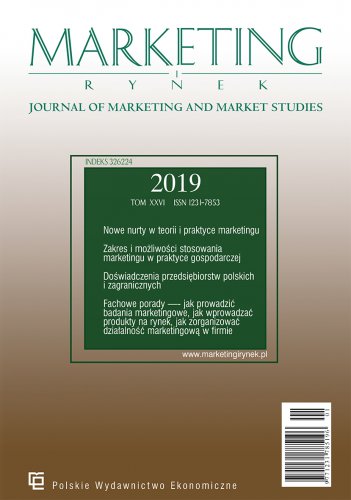Editorial
The topic of this special issue of „Journal of Marketing and Market Studies” is experiential marketing, a concept that has emerged in the marketing science in the late 90-ties. Its main assumption lies in the claim that contemporary customers are bored with traditional marketing tools and techniques and seek memorable experiences that would stimulate them in a sensory way, evoke real emotions, provoke them intellectually and allow to become members of a certain community. The experiential marketing originally focused on ‘creative’ industries, i.e. entertainment and tourism, but nowadays this concept spreads to more mundane industries, such as retailing and banking. It is believed that memorable customer experiences bond the customer with the brand via increased satisfaction, engagement and loyalty. In turn, companies increase their profitability, market share, as well as brand reputation and recognition. The concept of experiential marketing has been increasingly studied by Polish authors, to whom we dedicate this special issue.
This two-part special issue includes seven papers, among which there is one literature review, two methodological papers devoted to the development and validation of new techniques of measuring customer experiences, three empirical studies and a bibliometric analysis.
The first paper describes the state of research on experiential marketing in Poland (Dziewanowska & Kacprzak). The systematic literature review method was employed to collect relevant empirical studies on the topic and analyze the main research directions. It appears that customer experience is still a novelty in Polish marketing science, with most of the papers in this field being published after 2016. The majority of articles present case studies focused on the use of experiential marketing in a certain organization or industry. The need for quantitative and qualitative studies, which would not only replicate western concepts but also test new and original ones and develop methods of measuring customer experience, is clearly visible.
The second paper – by A. Dąbrowska & M. Janoś-Kresło – focuses on the importance of the customer experience in service marketing and presents the results of two quantitative studies conducted among two interesting market segments: single individuals and customers aged 60+. The article is also supplemented with a qualitative study – 18 individual interviews with service companies’ employees. The Authors point to the disturbingly high number of customers with ambivalent attitude to service providers which contradicts the experiential marketing rule of delivering exceptional and unforgettable experiences.
In the following paper M. Gębarowski presents a bibliometric analysis of the papers on extreme forms of tourism such as war-zone tourism or tombstone tourism, which according to the Author represent new fields of the experience economy. As a result, the Author points to gaps in the existing body of literature that can be filled by future studies in extreme tourism.
M. Spychalska-Wojtkiewicz & M. Tomczyk in their paper merge the design thinking concept with experiential marketing. Design thinking is a new approach to innovation that puts human needs in the center of the innovation process. The results of qualitative studies on an international sample of managers prove that design thinking is a useful method of designing innovative customer experiences.
Next papers of this special issue partially fill the gap mentioned above by providing two new methods of measuring customer experience. The paper by M. Mengoni et al. presents a tool developed to measure customer emotions by analyzing their facial expressions. Prof. Mengoni with her team from EMOJ (a spin-off company of Polytechnic University of Marche, Italy) has developed the tool and tested its possibilities during an opera festival in Macerata. It opens new possibilities to improve the quality of cultural events as the customer emotions can be matched with the exact point in time during the show.
The subsequent paper by M. Ścibor-Rylski and his team from Kantar Polska research agency describes the use of two new tools that measure the customer experience – a qualitative, employing gamification (“Our city” game), and a quantitative one (CX+). The use of a board game developed online allows to reconstruct a customer journey map as well as category entry points and all circumstances that may influence the final customer experience. In turn, the CX+ instrument measures the consistency of a brand promise and delivered customer experience. The paper also provides results of validation studies for both tools.
The last paper – by Z. Spyra – is devoted to the topic of building a brand communication strategy in social media. The proposed model is called SMART and its key elements of communications comprise: synergy, methodicalness, attractiveness of the content, reactivity and transposition. The proposed model was tested in a quantitative study on a sample of 709 young consumers, which allows to rank the elements of the model from most to least important.
We hope you will find these papers interesting and inspiring!
Guest Editors
dr hab. Agnieszka Kacprzak & dr hab. Katarzyna Dziewanowska

